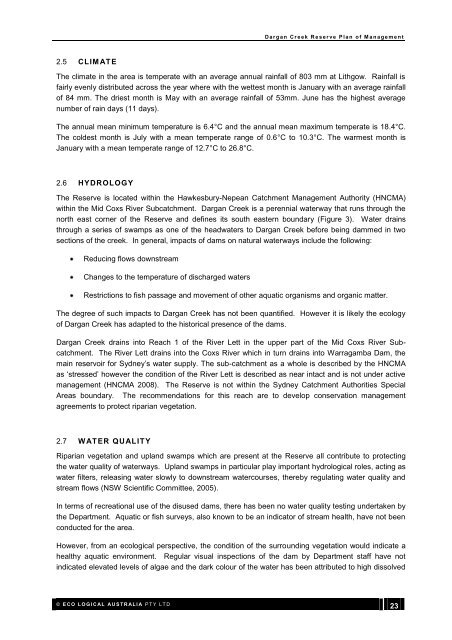Draft Plan of Management for the Dargan Creek Reserve - Land
Draft Plan of Management for the Dargan Creek Reserve - Land
Draft Plan of Management for the Dargan Creek Reserve - Land
You also want an ePaper? Increase the reach of your titles
YUMPU automatically turns print PDFs into web optimized ePapers that Google loves.
D a r g a n C r e e k R e s e r v e P l a n o f M a n a g e m e n t<br />
2.5 CLIM ATE<br />
The climate in <strong>the</strong> area is temperate with an average annual rainfall <strong>of</strong> 803 mm at Lithgow. Rainfall is<br />
fairly evenly distributed across <strong>the</strong> year where with <strong>the</strong> wettest month is January with an average rainfall<br />
<strong>of</strong> 84 mm. The driest month is May with an average rainfall <strong>of</strong> 53mm. June has <strong>the</strong> highest average<br />
number <strong>of</strong> rain days (11 days).<br />
The annual mean minimum temperature is 6.4°C and <strong>the</strong> annual mean maximum temperate is 18.4°C.<br />
The coldest month is July with a mean temperate range <strong>of</strong> 0.6°C to 10.3°C. The warmest month is<br />
January with a mean temperate range <strong>of</strong> 12.7°C to 26.8°C.<br />
2.6 HYDROLOGY<br />
The <strong>Reserve</strong> is located within <strong>the</strong> Hawkesbury-Nepean Catchment <strong>Management</strong> Authority (HNCMA)<br />
within <strong>the</strong> Mid Coxs River Subcatchment. <strong>Dargan</strong> <strong>Creek</strong> is a perennial waterway that runs through <strong>the</strong><br />
north east corner <strong>of</strong> <strong>the</strong> <strong>Reserve</strong> and defines its south eastern boundary (Figure 3). Water drains<br />
through a series <strong>of</strong> swamps as one <strong>of</strong> <strong>the</strong> headwaters to <strong>Dargan</strong> <strong>Creek</strong> be<strong>for</strong>e being dammed in two<br />
sections <strong>of</strong> <strong>the</strong> creek. In general, impacts <strong>of</strong> dams on natural waterways include <strong>the</strong> following:<br />
Reducing flows downstream<br />
Changes to <strong>the</strong> temperature <strong>of</strong> discharged waters<br />
Restrictions to fish passage and movement <strong>of</strong> o<strong>the</strong>r aquatic organisms and organic matter.<br />
The degree <strong>of</strong> such impacts to <strong>Dargan</strong> <strong>Creek</strong> has not been quantified. However it is likely <strong>the</strong> ecology<br />
<strong>of</strong> <strong>Dargan</strong> <strong>Creek</strong> has adapted to <strong>the</strong> historical presence <strong>of</strong> <strong>the</strong> dams.<br />
<strong>Dargan</strong> <strong>Creek</strong> drains into Reach 1 <strong>of</strong> <strong>the</strong> River Lett in <strong>the</strong> upper part <strong>of</strong> <strong>the</strong> Mid Coxs River Subcatchment.<br />
The River Lett drains into <strong>the</strong> Coxs River which in turn drains into Warragamba Dam, <strong>the</strong><br />
main reservoir <strong>for</strong> Sydney‟s water supply. The sub-catchment as a whole is described by <strong>the</strong> HNCMA<br />
as „stressed‟ however <strong>the</strong> condition <strong>of</strong> <strong>the</strong> River Lett is described as near intact and is not under active<br />
management (HNCMA 2008). The <strong>Reserve</strong> is not within <strong>the</strong> Sydney Catchment Authorities Special<br />
Areas boundary. The recommendations <strong>for</strong> this reach are to develop conservation management<br />
agreements to protect riparian vegetation.<br />
2.7 W ATER QUALITY<br />
Riparian vegetation and upland swamps which are present at <strong>the</strong> <strong>Reserve</strong> all contribute to protecting<br />
<strong>the</strong> water quality <strong>of</strong> waterways. Upland swamps in particular play important hydrological roles, acting as<br />
water filters, releasing water slowly to downstream watercourses, <strong>the</strong>reby regulating water quality and<br />
stream flows (NSW Scientific Committee, 2005).<br />
In terms <strong>of</strong> recreational use <strong>of</strong> <strong>the</strong> disused dams, <strong>the</strong>re has been no water quality testing undertaken by<br />
<strong>the</strong> Department. Aquatic or fish surveys, also known to be an indicator <strong>of</strong> stream health, have not been<br />
conducted <strong>for</strong> <strong>the</strong> area.<br />
However, from an ecological perspective, <strong>the</strong> condition <strong>of</strong> <strong>the</strong> surrounding vegetation would indicate a<br />
healthy aquatic environment. Regular visual inspections <strong>of</strong> <strong>the</strong> dam by Department staff have not<br />
indicated elevated levels <strong>of</strong> algae and <strong>the</strong> dark colour <strong>of</strong> <strong>the</strong> water has been attributed to high dissolved<br />
© E C O L O G I C A L A U S T R A L I A P T Y L T D<br />
23

















